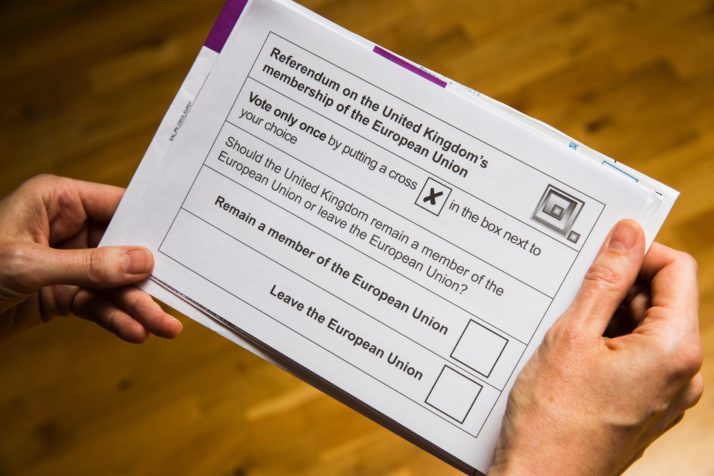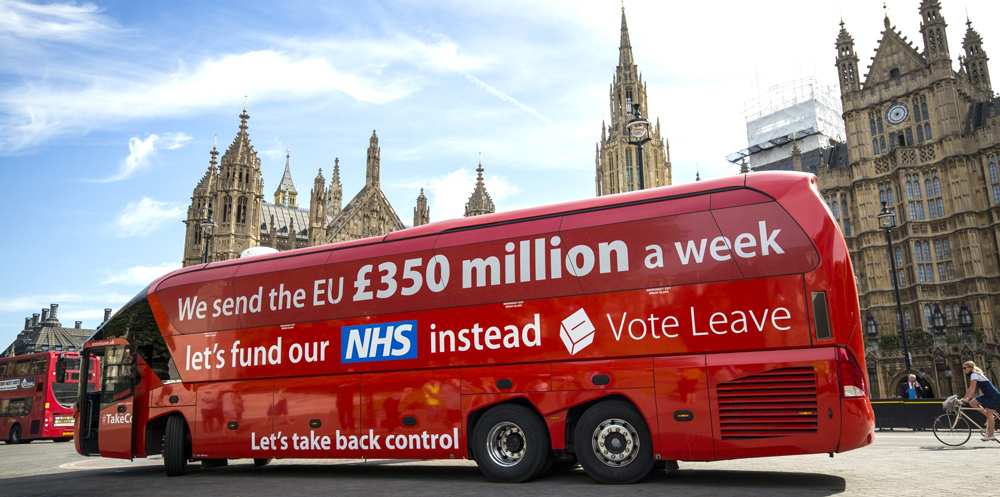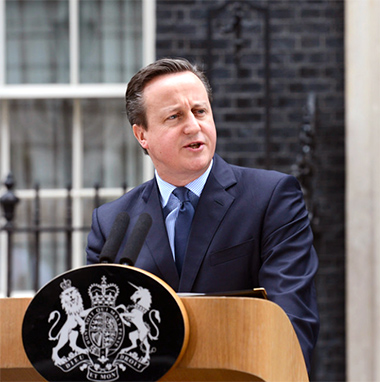Brexit: A Timely Primer
By Tom PorterWith just weeks to go until Brexit and still no deal in sight, two political science professors lead a discussion on the UK’s historic decision by referendum to leave the European Union. Why did it happen? What does it mean?

Bowdoin students, along with other members of the College community, filled Kresge Auditorium on February 5 to learn more about one of the major political issues facing the world today: the UK’s historic decision to leave the European Union. Ever since the Brits voted “Leave” in the June 2016 referendum, efforts have been underway to figure out exactly how this is going to happen and what it’s going to look like.
With Brexit due to happen on March 29, 2019, regardless of whether or not a deal has been reached with the EU, political efforts to prepare for the event have become increasingly frenzied. Associate Professor of Government Laura Henry, who teaches The Politics of the European Union (GOV 2500), teamed up with Associate Professor of Government and Asian Studies Henry Laurence (who also teaches a course on British politics) for a joint presentation about Brexit and to answer some questions, including what might Britain look like after March 29?
Origins of the EU
The EU has its origins in the European Economic Community (EEC), or the Common Market. Established in 1957, it was the result of the prevailing postwar belief in several European countries that continental unity could serve as an antidote to the nationalism that led to World War II, explained the professors.
Britain initially felt a little disengaged toward this European project, said Henry, and while supportive of integration, did not tend to see itself as being at the heart of European affairs. “Britain was always a slightly awkward member of the European community and was not one of original six EEC-member states,” she added.
By the 1960s, however, the economic benefits of being in the EEC became clear, explained Laurence, prompting Britain to try twice to join. Both efforts, in 1963 and 1967, were blocked by French president Charles de Gaulle. In 1973, with de Gaulle gone from power, a third attempt was successful, said Laurence, beginning a long and tumultuous relationship, which, forty-six years later, looks to be coming to an end.

Bananas, Buses, and Barmaids
British membership was popular at first, said Laurence, who is a native of England. “The first referendum on UK membership was held in 1975, and the ‘Remainers’ won handsomely, with 67 percent of the vote.” As time went on, however, the Common Market (which became the European Union in 1993) increasingly became a scapegoat for the populist British press.
“Brussels became the butt of many jokes, and some crazy myths began to circulate about insane EU regulations,” he explained. “One myth alleged that Brussels would require bananas to be straight, another claimed the Europeans would ban British double-decker buses. Perhaps the strangest, though, was a claim that barmaids would be required to cover up their cleavages due to EU health safety regulations regarding sunburn prevention!”
The political break with Europe came in the late 1980s and early 1990s, said Laurence, when Prime Minister Margaret Thatcher turned Euroskeptic. “She was the first Conservative leader to break with the EU and say it’s not in Britain’s interests to be a member.” Not that the Conservative Party was the only one to harbor anti-EU sentiment, he added. “The left wing of the Labour Party had always been suspicious of the EU, fearing it could undermine some of the party’s socialist goals.” He pointed out that the current Labour leader, Jeremy Corbyn, voted against EU membership as a young legislator in the 1975 referendum. So, although Euroskepticism is more prevalent in the Conservative Party, said Laurence, both parties are split on the issue, making Brexit a topic that cuts across party lines.
Issues and Campaigns
As the EEC became the EU, European integration deepened and more countries joined. By the summer of 2004, twenty-five nations were on board. Immigration became a huge political issue, said Henry, seized upon by EU opponents in Britain to strengthen their argument against membership.
Although the UK did negotiate a number of opt-outs regarding its EU membership, such as keeping the pound rather than joining the single currency and maintaining more control over justice and home affairs than other member nations, Henry said there was increasing skepticism over what was seen as the tightening control of Brussels over domestic matters. One particularly contentious issue, she said, was an effort by the European Parliament to end the UK’s ban on prisoner voting.
Initially regarded as the preserve of a few people on the “political fringe,” support for separation from Europe grew and grew, said Laurence, as the brilliantly managed Brexit campaign argued they were reclaiming British sovereignty. “Brexiteers claimed they would enable the UK to take advantage of emerging markets in a way that it never could inside the EU. They also said Britain was sending more money to the EU than it received, and that the money could be better used at home.”
Some of the Brexit campaign statements were misleading or even false, said Laurence, including, most notably perhaps, the claim plastered on the side of the campaign bus stating that the country would be 350 million pounds (455 million dollars) per week better off under Brexit, and the money could be used to fund the National Health Service.

The arguments of the “Remain” campaign were a little less passionate, said Henry, invoking factors like economic expediency rather than national sovereignty. “The Remainers argued that Britain can compete more effectively as part of a trading bloc than it could on its own. They also stoked concern about the impact that the likely loss of London’s huge financial services industry would have in the event of Brexit,” she added.
The Leave campaign was successful by a margin of 52 to 48 percent. Part of the reason for the failure of the Remain campaign, said Laurence, was its emphasis on what the UK would lose by leaving the EU rather what it would gain by staying in.
“The Remainers failed to build a solid emotional case to back up their argument. They also never figured out how to deal with the contentious issue of immigration. They avoided the issue, which ceded ground to the opposition.”
—Henry Laurence
Why did Brexit happen in the first place?
 The person you can thank (or blame) more than anyone else for Brexit, said Laurence, is former Conservative Prime Minister David Cameron. In 2013, Cameron promised to hold a referendum on leaving the EU if he won the next election. “It was an attempt to manage his own party and buy off the right-wing Euroskeptics.”
The person you can thank (or blame) more than anyone else for Brexit, said Laurence, is former Conservative Prime Minister David Cameron. In 2013, Cameron promised to hold a referendum on leaving the EU if he won the next election. “It was an attempt to manage his own party and buy off the right-wing Euroskeptics.”
When the Tories comfortably won the 2015 election, Cameron had to follow through with this promise, explained Laurence, “but the prime minister and most of his advisors didn’t think there was any prospect of it passing.” In 2016 they were proved wrong, and the following year, on March 29, newly appointed Prime Minister Theresa May invoked Article 50 of the Lisbon Treaty, which triggered a two-year process to withdraw from the EU. Those two years are nearly up, and there is still no agreement between the UK parliament and the EU on how Britain will separate itself from the EU.
What now?
The two professors highlighted a number of scenarios that could play out after March 29.
- An agreement is reached. Prime Minister May has already made one, unsuccessful, effort to broker an agreement with the EU that is acceptable to the UK parliament. She has said she will keep trying, but one key sticking point is the so-called Irish “backstop” clause, an effort to resolve the effect that Brexit would have on trading relations between Northern Ireland (which is part of Britain) and the Republic of Ireland (which would remain in the EU).
- A “hard” Brexit. If no deal is reached, Britain is likely to crash out of the EU and revert to World Trade Organization rules to govern its international commerce. “However, even that scenario is a bit of a myth,” explained Henry, who pointed out that Britain is not even ready for a hard Brexit as things stand. “The UK would need to pass nine major statutes and six hundred statutory implements to actually be in compliance with the WTO as an individual state rather than a member of the EU.”
- The Norway and Switzerland options. These types of deals represent varying degrees of cooperation with the EU. Both countries have trading agreements allowing them access to EU markets, but, as Laurence pointed, they pay substantially for the privilege and, as non-EU members, have no authority over the rules—something that’s not likely to be popular in the UK.
- An extension of Article 50. This would postpone Britain’s exit from the EU and give everyone more breathing space, but other than that, said Henry, “it’s not clear what this option would achieve.”
- A second referendum. A number of Remainers have called for this but, on the whole, said Laurence, there doesn’t seem to be much appetite for it. There’s no indication that Britons have changed their minds enough on the issue to change the outcome of a second vote, he added. “Even in Parliament, most MPs are now committed to delivering Brexit.”
Professors Henry and Laurence both agreed that this is one of the most intractable problems ever faced by British politicians. “One reason the parliamentary negotiations are in such a stalemate,” said Laurence, “is that neither leader can deliver their party. But while the political gridlock continues,” he added, “the Brexit clock keeps ticking.”